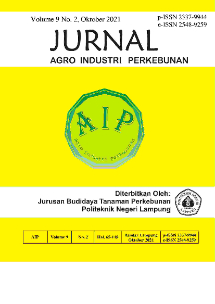Pemodelan Kondisi Optimum Ekstraksi dan Identifikasi Senyawa Penyusun Minyak Atsiri Lada Hitam
DOI:
https://doi.org/10.25181/jaip.v9i2.2132Keywords:
composition, extraction, GCMS, response surface methodAbstract
Black pepper is a spice with a spicy taste and a distinctive aroma that has become known as the King of Spices. The distinctive aroma of black pepper comes from the volatile compounds that make up the essential oil of pepper. Black pepper essential oil has antimicrobial properties that can relieve respiratory infections and relieve muscle disorders. The acquisition of pepper essential oil from the distillation process is influenced by operating conditions. The aim of this study was to identify the composition of black pepper essential oil compounds using GCMS and to optimize the operating conditions (material size, solvent ratio, and distillation time). The method used to determine the optimum condition is using the Response Surface Method (RSM). The results showed that the highest yield of black pepper essential oil from this experiment is 5.14%. The empirical model was also suitable for the experiment and the optimum conditions for producing the maximum pepper oil yield 5,81% were 40 mesh of material size, 0.12 (g.ml-1) of solvent ratio and 162 minutes of distillation time. GCMS test results showed that the main constituents of pepper essential oil are caryophyllene, ocimene, limonene, carene, and a-pinene.Downloads
References
Alyaseen, F. F., Hassan, B. A., & Abdulhussein, H. S. (2018). Extraction, isolation and chemical identification of piperine alkaloid from black pepper seeds and its antibacterialactivity. Plant Archives, 18(2), 2171–2176.
Alam, P. N., Husin, H., Asnawi, T. M., & Adisalamun. (2018). Extraction of citral oil from lemongrass (Cymbopogon Citratus) by steam-water distillation technique. IOP Conf. Ser.: Mater. Sci. Eng. 345 012022. https:// doi:10.1088/1757-899X/345/1/012022
Anggraini, R., Jayuska, A., & Alimuddin, A. H. (2018). Isolasi dan karakterisasi minyak atsiri lada hitam (Piper nigrum L.) asal sajingan kalimantan barat. Jurnal Kimia Khatulistiwa, 7(4), 124–133.
Anuar, N., Mohd Adnan, A. F., Saat, N., Aziz, N., & Mat Taha, R. (2013). Optimization of extraction parameters by using response surface methodology, purification, and identification of anthocyanin pigments in melastoma malabathricum fruit. The Scientific World Journal, 2013. https://doi.org/10.1155/2013/810547
Astani, A., & Schnitzler, P. (2014). Antiviral activity of monoterpenes beta-pinene and limonene against herpes simplex virus in vitro. Iranian Journal of Microbiology, 6(3), 149–155.
Dosoky, N. S., Satyal, P., Barata, L. M., Da Silva, J. K. R., & Setzer, W. N. (2019). Volatiles of black pepper fruits (Piper nigrum L.). Molecules, 24(23), 1–13. https://doi.org/10.3390/molecules24234244
Fidyt, K., Fiedorowicz, A., Strządała, L., & Szumny, A. (2016). β‐caryophyllene and β‐caryophyllene oxide—natural compounds of anticancer and analgesic properties. Cancer medicine, 5(10), 3007-3017. https://doi.org/10.1002/cam4.816
Klauke, A. L., Racz, I., Pradier, B., Markert, A., Zimmer, A. M., Gertsch, J., & Zimmer, A. (2014). The cannabinoid CB2 receptor-selective phytocannabinoid beta-caryophyllene exerts analgesic effects in mouse models of inflammatory and neuropathic pain. European Neuropsychopharmacology, 24(4), 608–620. https://doi.org/10.1016/j.euroneuro.2013.10.008
Kusuma, H. S., & Mahfud, M. (2015). Preliminary study: Kinetics of oil extraction from sandalwood by microwave-assisted hydrodistillation. ASEAN Journal of Chemical Engineering, 15(2), 62–69. https://doi.org/10.22146/ajche.49687
Lee, J. G., Kim, D. W., Shin, Y., & Kim, Y. J. (2020). Comparative study of the bioactive compounds, flavours and minerals present in black pepper before and after removing the outer skin. Lwt, 125(January), 109356. https://doi.org/10.1016/j.lwt.2020.109356
Mahdian, F., Mahboubi, M., Rahimi, E., & Shad, M. M. (2017). Chemical composition, antimicrobial and antioxidant activities of Echinophora platyloba essential oil. Infectio, 21(3), 176–181. https://doi.org/10.22354/in.v21i3.675
Pawignya, H., Kusworo, T. D., & Pramudono, B. (2019). Optimization for Production Tert-Butyl Glycoside Nonionic Surfactant Using Response Surface Methodology. Journal of Physics: Conference Series, 1295(1). https://doi.org/10.1088/1742-6596/1295/1/012003
Rmili, R., Ramdani, M., Ghazi, Z., Saidi, N., & El Mahi, B. (2014). Composition comparison of essential oils extracted by hydrodistillation and microwave-assisted hydrodistillation from Piper nigrum L. Journal of Materials and Environmental Science, 5(5), 1360–1367.
Tran, T. H., Ha, L. K., Nguyen, D. C., Dao, T. P., Nhan, L. T. H., Nguyen, D. H., Nguyen, T. D., Vo, D. V. N., Tran, Q. T., & Bach, L. G. (2019). The study on extraction process and analysis of components in essential oils of black pepper (Piper nigrum L.) seeds harvested in Gia Lai Province, Vietnam. Processes, 7(2). https://doi.org/10.3390/pr7020056
Downloads
Published
How to Cite
Issue
Section
License
Copyright (c) 2021 Shintawati Shintawati, Analianasari Analianasari, Zukryandry Zukryandry

This work is licensed under a Creative Commons Attribution-ShareAlike 4.0 International License.
Authors who publish with Jurnal Agro Industri Perkebunan agree to the following terms:
Authors retain copyright and grant the Jurnal Agro Industri Perkebunan right of first publication with the work simultaneously licensed under a Creative Commons Attribution License (CC BY-SA 4.0) that allows others to share (copy and redistribute the material in any medium or format) and adapt (remix, transform, and build upon the material for any purpose, even commercially) with an acknowledgment of the work's authorship and initial publication in Jurnal Agro Industri Perkebunan.
Authors are able to enter into separate, additional contractual arrangements for the non-exclusive distribution of the journal's published version of the work (e.g., post it to an institutional repository or publish it in a book), with an acknowledgment of its initial publication in Jurnal Agro Industri Perkebunan. Authors are permitted and encouraged to post their work online (e.g., in institutional repositories or on their website) prior to and during the submission process, as it can lead to productive exchanges, as well as earlier and greater citation of published work.


























